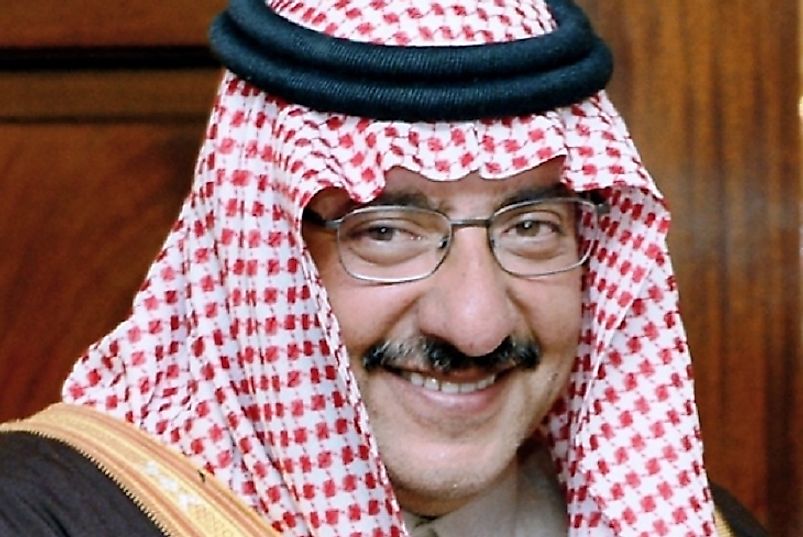Crown Princes Of Saudi Arabia

Appointed by the Saudi King as his successor and to rule in his stead during his absence, the Crown Prince of Saudi Arabia is one of the most powerful men in Saudi Arabia. His position is only second in prominence to that of the King. This arrangement has been in place since the Abdullah Era. A good equivalent would be the Prime Minister in Western democracies, and that is if the Prime Minister were also the successor to the throne. Succession to the throne is confined to the House of Saud, the ruling dynasty of Saudi Arabia. The Saud family has been in power since the time of Muhammad bin Saud who began his reign in 1765 and died in 1819. He was the Emir of Ad-Diriyyah, which included present-day Riyadh and was the first Saudi state.
Saud bin Abdulaziz Al Saud
Saud bin Abdulaziz Al Saud was the second son of King Abdulaziz, who became king after he had completed the unification of Saudi Arabia in 1932. Before the time of King Abdulaziz, succession to the Saudi throne passed exclusively from father to son. But when King Abdulaziz's eldest son, Turki, died in a flu outbreak in 1919, Turki's only child was still in his mother's womb. Therefore Abdulaziz named his second son, Turki's brother Saud as the Crown Prince in May 1933. Prince Saud led a military expedition to Yemen in 1934, regaining Najran for Saudi Arabia. When Abdulaziz died in 1933, Saud succeeded him as king and his brother Faisal became the Crown Prince.
Faisal bin Abdulaziz Al Saud
There was constant wrangling between King Saud and his brother, Prince Faisal, with the latter questioning his brother's competence. Prince Faisal was an ambitious man, and from his youth had proved himself a man of decisive action. He had in 1925 led an army of Saudi loyalists and captured the Hejaz. In 1927 he became the viceroy of Hejaz. King Saud's financial policies frustrated the Prince. The king was planning to build a luxurious palace on the outskirts of Riyadh. The Ulema (Saudi Arabia's religious leadership) united with the royal family to pressure the king into appointing Prince Faisal as Prime Minister and increasing his power. Prince Faisal used his new powers to cut down on spending in a bid to avert bankruptcy, which seemed inevitable if the King's spending habits persisted. Frustrated, Prince Faisal resigned in 1960, accusing the King of derailing his financial reforms. Consequently, the King appointed their half-brother Prince Talal as the Minister of Finance. However, after rallying enough influence and support from the royal family, Crown Prince Faisal reinstalled himself as the Prime Minister. The prince was famous for reform and modernizing policies such as introducing education to women in Saudi Arabia, a conservative Muslim country. The prince took advantage of his position to eliminate the King's allies from the government, building a strong base of influence for himself until 1964 when he overthrew Saud and became the third king of unified Saudi Arabia.
Khalid bin Abdulaziz Al Saud
When Faisal became king, his brother Muhammad bin Abdulaziz al-Saud became the crown prince. However, after only a few months, Muhammad stepped down, and another brother, Khalid bin Abdulaziz al-Saud, became the new Crown Prince and heir to the throne in 1965. King Faisal appointed Prince Khalid as the First Deputy Prime Minister of Saudi Arabia, with the responsibility of governing the council of ministers. It is believed that Prince Khalid was chosen heir because of his indifferent attitude to politics. It was easy for the different branches of the royal family to agree on him, ensuring minimal disputes. King Faisal was assassinated in 1975, and Prince Khalid succeeded him as king.
A Position of Honor
The present Crown Prince is Muhammad bin Nayef bin Abdulaziz Al Saud, who was appointed by King Salman in 2015 to replace Prince Muqrin, who was relieved of his position after only three months of service. The post of the crown prince is part of an honorable tradition. It enables the future king a suitable training ground in readiness for his future responsibilities. As the First Deputy Prime Minister, the Crown Prince is in a position to exercise power, to gain experience worthy of a ruler, and to reflect on what sort of king he will be once he ascends the throne.
Crown Princes Of Saudi Arabia
| Crown Princes of Saudi Arabia | Time as Crown Prince |
|---|---|
| Saud bin Abdulaziz Al Saud | 1933-1953 |
| Faisal bin Abdulaziz Al Saud | 1953-1964 |
| Muhammad bin Abdulaziz | 1964-1965 |
| Khalid bin Abdulaziz Al Saud | 1965-1975 |
| Fahd bin Abdulaziz Al Saud | 1975-1982 |
| Abdullah bin Abdulaziz Al Saud | 1982-2005 |
| Sultan bin Abdulaziz Al Saud | 2005-2011 |
| Naif bin Abdulaziz Al Saud | 2011-2012 |
| Salman bin Abdulaziz Al Saud | 2012-2015 |
| Muqrin bin Abdulaziz | 2015 |
| Muhammad bin Nayef bin Abdulaziz Al Saud (Incumbent) | 2015-Present |







